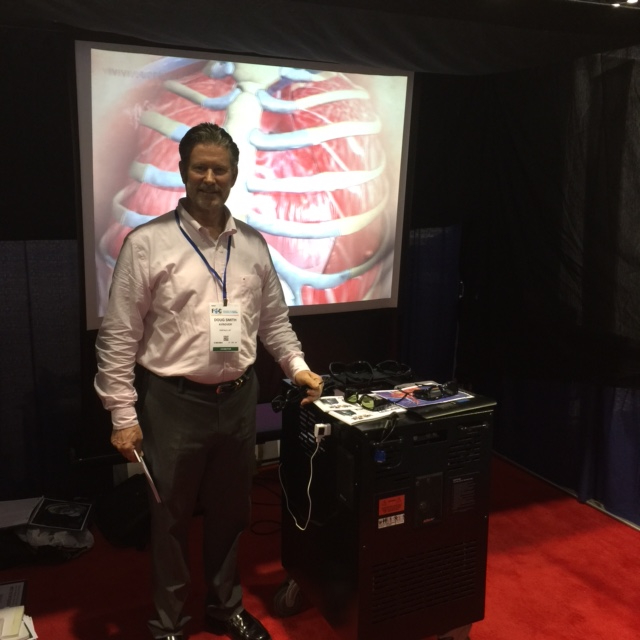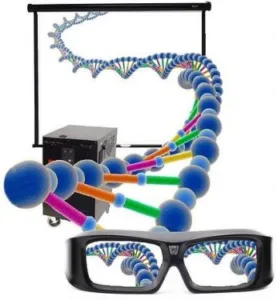There’s a lot of bustle around a certain booth at recent ed-tech conferences, and it is attention that is richly deserved. You see, AVRover has been around a long time, since the very beginning of digital 3D’s move into education. Amid constant technological upheaval, that’s staying power. Here’s their story: past, present, and future.

When the stereo 3D education movement got started, most of the big industry players felt that the best environment for learning in 3D was the 3D ‘room’: the 3D cave, the 3D lab, the 3D dome, or the dedicated in-school 3D theater. But it was too hard to move the students to the buildings where 3D was located. Transportation costs and headaches presented themselves for district-centralized locations. Similarly, it took too much time in a large high school to shuffle a class of students to a dedicated in-school 3D teaching space. Valuable instructional time was easily lost. Doug Smith, President of AVRover recalled: “We soon determined it would be a lot easier to bring 3D to students rather than students to 3D. That’s how our product was born”. Thus, AVRover makes a transportable and all-in-one stereo 3D viewing center – in short, a portable classroom 3D solution. And it is easy to use. It can be rolled into a classroom and ready to use in under two minutes.
At the outset of the 3D in learning movement, technical considerations also complicated the environment. Since 3D content could not be streamed (and still can’t for the time being), 3D resources had to be directly connected to the projector or display showing the resource. As a result, producers licensed their software to a specific computer. If you wanted to show 3D in five classrooms, you had to buy five licenses, five displays, five configured computers – you get the picture. These restrictive and medieval licensing policies further diminished the expansion of 3D across the educational world. (Medieval from the perspective of experienced school technologists, that is.) According to Smith, “this drove the industry in the US to lean more toward portable solutions”.
So, AVRover has been at it since the very beginning of the digital 3D movement and they are still here, continuously improving and upgrading their solution, based on customer input. The results have been impressive for this small company. Touted as “a classroom’s best friend”, AVRover is now pushing toward 500 installations in the US, an unarguable success story. Clearly, that’s the best penetration of stereo 3D in the US. Currently, 90% of AVRover’s business is in the K-12 market and 10% is in higher-ed, military and industrial training programs.
The near future is looking good for this remarkably patient company, as well. “For the first time, we have major districts looking at multiple installations – we’ve never seen this before”, confessed Smith. “We are expecting to sell more this year than in the last four years combined”. Now, I describe AVRover as a patient company, because many others in this industry seem to be in a hurry…in a rush to expand, to scale, to make the big deal, to become the next big thing. “We are successful at what we are doing”, remarks Smith. “Our specialty is portable classroom solutions, and all this work is finally coming to fruition – it’s starting to go mainstream – with sales of hundreds instead of tens of machines”. Clearly, their patience is being rewarded.Doug Smith, President of AVRover
 Doug Smith, President of AVRoverWhat does Smith see for the future of educational 3D? “Lots more content, many more subject areas”, he offers. You can also expect a strong move toward the higher-ed market from AVRover, as they continue to disintermediate the 3D learning experience away from the centralized presentation facility. Attempting to future-proof their product for advent of immersive virtual reality and other advancements, AVRover has built a window in the back of their solution to permit hooking up the XBox and Xbox Connect and other solutions like the Xbox Kinect technologies. Most interestingly, Smith sees a new pathway for content producers who, unlike the traditional publishers producing only math and science content, will soon be pursuing virtual reality walk-throughs, robust simulations and vocational/industry training content. Although the content has not yet caught up, AVRover is poised and ready. – Len Scrogan
Doug Smith, President of AVRoverWhat does Smith see for the future of educational 3D? “Lots more content, many more subject areas”, he offers. You can also expect a strong move toward the higher-ed market from AVRover, as they continue to disintermediate the 3D learning experience away from the centralized presentation facility. Attempting to future-proof their product for advent of immersive virtual reality and other advancements, AVRover has built a window in the back of their solution to permit hooking up the XBox and Xbox Connect and other solutions like the Xbox Kinect technologies. Most interestingly, Smith sees a new pathway for content producers who, unlike the traditional publishers producing only math and science content, will soon be pursuing virtual reality walk-throughs, robust simulations and vocational/industry training content. Although the content has not yet caught up, AVRover is poised and ready. – Len Scrogan

